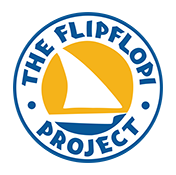FlipFlopi HQ in Lamu gets a visit from Jane Davis.
Written by Ben Morison
On Friday morning we had the great pleasure to host Jane Davis, who is a Scientific Exploration Society council member, and also a good friend of one of our advisors – John Blashford Snell. Jane was born and educated in Kenya, and has lots of experience working with plastics, so naturally she was very interested to learn more about The FlipFlopi Project.
After a briefing earlier in the week from project leader Ben, Jane and her travel companions were met by Ali Skanda, the head of our boat building team, who showed them around his boatyard where The FlipFlopi Dhow is being built. Ali also gave the group a tour around the MV Tunda, the wooden dhow you see in the photos below – which is identical in size and shape to The FlipFlopi Dhow.
Ali is the last generation of a long line of dhow builders and wood carvers… he was able to explain the cultural significance of Dhow building to the people of Lamu, and the fact that big Dhows are no longer being built on the East African coast because all the big trees required for their manufacture have now been cut down. He explained how the plastic moulding process being pioneered by The FlipFlopi Project is providing a brilliant alternative source for the same big pieces, and therefore has the potential to rejuvenate what was hitherto a fast declining craft.
Jane has worked for a number of years in the FMCG (fast moving consumer goods) sector and has first-hand experience of the use of injection and blow moulding processes in the plastics and packaging industry for branded products sold to supermarkets in the UK – so she was particularly interested to learn about how The FlipFlopi Dhow was being built entirely from waste plastic collected from beaches and towns on the Kenya coast. [If you don’t know how we are doing this – have a look at this photo based explanation]
After the visit Jane said;
*"I am very grateful to you for inviting me to view your exciting project. In the UK we have recently imposed a 5p tax on shopping bags – and the success has been phenomenal. I understand that so far it has saved 5 billion bags from being taken home from shops, a reduction of 85%. And it has proven that the public are willing to participate. In fact I went shopping yesterday in Lamu and I was very impressed by one of the shops actually asking me if I wanted a carrier bag. Thanks to the UK’s 5p tax – I have been well educated now – and was able to get out my folded plastic bag from my handbag to use!
Re-use and Re-cycle has reached Lamu.... Wonderful!"





